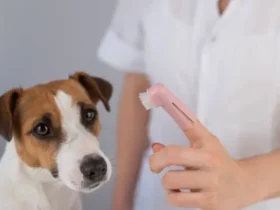As the seasons change, many dog owners experience a familiar challenge: the intense shedding known as “coat blowing.” This is the time of year when dogs shed their old coat to make way for a new one. While this natural process helps your dog stay comfortable in changing temperatures, it can be overwhelming to manage the sheer volume of fur that seems to cover everything in sight. In this blog, we’ll guide you through understanding coat blowing, provide effective management strategies, and offer tips to keep your home and your dog’s coat in top condition.
Understanding Coat Blowing
1. What Is Coat Blowing?
- Seasonal Shedding: Coat blowing refers to the seasonal shedding of a dog’s undercoat, which often occurs during spring and fall. This is when dogs transition between their lighter summer coat and their heavier winter coat.
- Natural Process: It’s a natural and healthy process, allowing dogs to adjust to the changing temperatures. The undercoat, which is softer and denser, is shed to regulate the dog’s body temperature.
2. Breeds Affected by Coat Blowing
- Double-Coated Breeds: Dogs with double coats are particularly affected by coat blowing. This includes breeds like Siberian Huskies, German Shepherds, Golden Retrievers, and Border Collies. These breeds have a dense undercoat that sheds heavily during this time.
- Single-Coated Breeds: Single-coated breeds, such as Poodles and Maltese, may shed less during coat blowing season, but they still require regular grooming to manage their fur.
Effective Management Strategies
1. Regular Grooming
Maintaining a consistent grooming routine is crucial for managing shedding:
- Brushing: Use a high-quality brush designed for your dog’s coat type. For double-coated breeds, consider tools like the undercoat rake or slicker brush to remove loose fur and prevent matting.
- Undercoat Rake: Ideal for reaching the dense undercoat and removing loose hair.
- Slicker Brush: Helps to remove tangles and loose hair from the topcoat.
- Frequency: Brush your dog’s coat several times a week during coat blowing season. This helps reduce the amount of fur that ends up around your home and keeps your dog’s coat healthy.
2. Bathing
Bathing your dog can help with the shedding process:
- Use Appropriate Shampoos: Choose a shampoo specifically designed for shedding dogs or one that promotes healthy skin and coat. Look for products with ingredients like omega fatty acids and aloe vera.
- Frequency: Bathe your dog as needed, but avoid over-bathing as it can strip natural oils from the coat and skin. Generally, once a month is sufficient, unless your dog gets particularly dirty.
3. Professional Grooming
If you find it challenging to manage shedding on your own:
- Groomer Services: Consider taking your dog to a professional groomer. They have specialized tools and techniques to handle excessive shedding and can provide services like deshedding treatments and thorough coat brushing.
- Consultation: Discuss your dog’s specific shedding issues with the groomer to tailor the grooming session to their needs.
4. Home Cleaning
Managing the fur that ends up around your home is also essential:
- Vacuuming: Use a vacuum cleaner designed for pet hair, which can handle the large amounts of fur that accumulate. Consider vacuuming upholstery and floors regularly.
- Lint Rollers: Keep lint rollers handy for quick clean-ups of pet hair on clothing and furniture.
- Washable Covers: Use washable covers on furniture to make cleaning easier. Regularly wash these covers to remove accumulated fur.
5. Diet and Health
A healthy diet can influence the quality of your dog’s coat and shedding:
- Balanced Nutrition: Feed your dog a high-quality, balanced diet to promote a healthy coat and skin. Look for foods with essential fatty acids, vitamins, and minerals.
- Hydration: Ensure your dog has access to fresh water at all times, as proper hydration supports healthy skin and coat.
Tips for Managing Excess Fur
1. Create a Designated Grooming Area
- Grooming Station: Set up a designated area for grooming where fur can be easily cleaned up. Use washable mats or covers to protect surfaces and make clean-up easier.
2. Use Fur-Friendly Products
- Deshedding Tools: Invest in tools designed to manage shedding, such as deshedding sprays or grooming gloves. These products can help reduce the amount of loose fur and keep your dog’s coat smooth.
3. Regular Check-Ups
- Veterinary Visits: Schedule regular veterinary check-ups to ensure that excessive shedding is not a sign of an underlying health issue. Discuss any concerns with your vet, especially if you notice changes in your dog’s skin or coat.
4. Seasonal Adjustments
- Adjust Grooming Routines: Be prepared to adjust grooming routines based on the season. During coat blowing, you might need to increase the frequency of brushing and baths to manage the shedding effectively.
Common Mistakes to Avoid
1. Over-Bathing
- Avoid Excessive Baths: Bathing your dog too frequently can lead to dry skin and irritation. Stick to a regular bathing schedule and use gentle, pet-safe shampoos.
2. Neglecting Grooming
- Regular Grooming is Key: Skipping grooming sessions can lead to matting, increased shedding, and discomfort for your dog. Maintain a consistent grooming routine throughout the year.
3. Using Human Products
- Avoid Human Shampoos: Do not use human shampoos or grooming products on your dog. These products can be too harsh and may cause skin issues.
4. Ignoring Health Issues
- Monitor Health: If you notice sudden or excessive changes in your dog’s shedding patterns, consult your veterinarian. Excessive shedding can sometimes be a sign of health problems that need to be addressed.
Conclusion
Coat blowing season can be a challenging time for dog owners, but with the right strategies, you can effectively manage your dog’s shedding and keep both your pet and your home in great shape. Regular grooming, proper bathing, and home cleaning are key to handling the fur that seems to fly everywhere. Additionally, maintaining a healthy diet and seeking professional grooming services can further help manage shedding.
By following these tips and techniques, you can ensure that coat blowing season is more manageable and less stressful for both you and your furry friend. If you have any additional tips or experiences managing your dog’s shedding, share them in the comments below. For more pet care advice and insights, stay tuned to our blog!










Leave a Reply